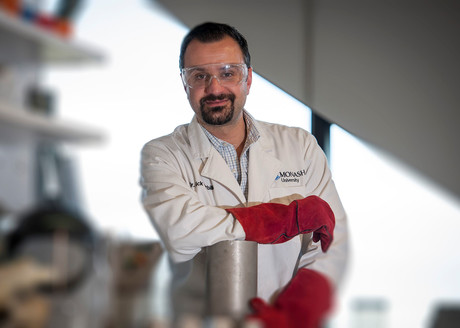Innovation medal awarded to outstanding young Australian engineer

One of Australia’s outstanding young engineering innovators will be awarded the prestigious Batterham Medal today, recognising his contributions to engineering over the last five years.
The winner of this year’s medal, which is administered by the Academy of Technology and Engineering (ATSE), is Monash University engineer Professor Nick Birbilis.
Professor Birbilis has had an impressive career to date. At 39 years old, he is a professor, the Head of Materials Science and Engineering and is the Woodside Innovation Chair at Monash University.
“Any celebration of achievements in STEM are extremely important, perhaps now more than ever,” said Professor Birbilis.
“Such awards not only elevate the profession, but also serve as platforms to notify and inspire young students or those looking towards a career in engineering. This award also highlights the role of ATSE as a voice for Australia’s technology and innovation capability.”
As an internationally recognised expert in corrosion, durability management and the behaviour of metallic elements, Birbilis solves problems both locally and globally across this broad range of engineering fields. He began his engineering career working in materials consulting with Maunsell (now AECOM). Before he transitioned into academia, he was already renowned across Australia for expertly tackling corrosion.
His signature contribution in the last five years was his breakthrough in developing lightweight ‘stainless’ magnesium and aluminium alloys. In contrast, stainless steels are heavy and rely on large amounts of chromium alloying. It’s Birbilis’s goal, however, to create corrosion-resistant ultra-lightweight versions of aluminium and magnesium alloys — for everything from portable electronics to structural materials.
“Corrosion of metals is the result of nature wanting to return the metal atoms back to their preferred raw form and the suppression of this involves innovation in corrosion control,” he said.
Corrosion costs approximately 3% of GDP (~$40 billion per year in the Australian context) — a figure equal to the output of the entire national agricultural industry. It is an electrochemical process corresponding to the disintegration of anthropogenic (man-made) materials into their constituent atoms. The materials we use to construct bridges, aircraft, vehicles, portable electronics, etc, are all anthropogenic. Consequently, we critically need to identify how corrosion commences, the mechanism by which it occurs and what processes or systems can halt such corrosion.
To this end, Birbilis has made seminal contributions to understanding localised corrosion processes as a consequence of research focused on the relationship between the structure of materials (at the atomic scale) and their corrosion initiation. For example, Birbilis’s frequently cited research has unravelled the fundamental role of material factors — such as grain size and precipitate dimensions — that influence corrosion.
He has developed several versions of stainless Mg alloys (published in the highest-ranking journals in his field), including a unique magnesium-lithium alloy (reported in Nature Materials) and magnesium-germanium/magnesium-arsenic alloys. Stainless magnesium was considered unthinkable prior to Birbilis’s work, but Birbilis does not conform to the past. Such work is not a fluke: it is based on deliberate research in partnership with the US Army Research Lab and giant alloy producer Baosteel.
Birbilis secured $10m of philanthropic funding from Woodside Energy (the largest philanthropic gift to Monash in history) on the basis of deploying technological innovation to create a future of new engineering practices. This investment in Birbilis’s engineering leadership promptly resulted in a saving to Woodside of $50–100 million, thanks to research permitting the substitution of steel with much lighter aluminium alloys.
At present, Birbilis is involved in a number of innovations surrounding the additive manufacturing (3D printing) of corrosion-resistant alloys. These alloys are already being deployed as ‘spares on demand’ in the field, and allow for the considerable reduction of inventory (estimated value: well in excess of $1 billion for Woodside alone). Translating these alloys — not previously produced by additive manufacturing — to a field setting is a significant a significant disruptor, creating new approaches with substantial economic benefits.
Livium’s LFP battery technology gains new investor interest
Livium's subsidiary VSPC has reported increased investor engagement following its recent...
Sydney recycling facility launched to give e-waste a new life
UNSW plastics recycling technology has found its first commercial use in an e-waste recycling...
Allegro electrolyte technology granted a US patent
Innovative micro-emulsion electrolyte technology positions Allegro as a frontrunner in the race...








